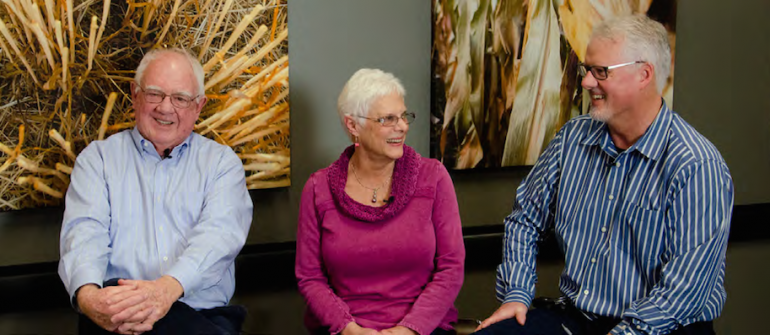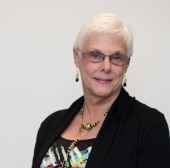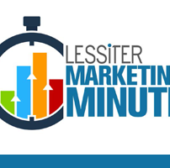By Dave Kanicki, Publisher
From the February 2019 Lessiter Link newsletter
Back in December, listeners of the Farm Equipment podcast series, “Conversations with Ag Equipment’s Entrepreneurs,” asked about LM’s story. Frank, Pam and Mike Lessiter were subsequently interviewed, and the resulting Jan. 10 podcast ran a little over 30 min. long.
The actual interview/conversation, however, lasted well over an hour. This article was written to provide our LM family the opportunity to enjoy some parts that didn’t make the final cut.
Because the podcast was specifically for FE, it focused on LM’s agricultural segment. However, a fair amount of time was spent discussing LM’s other publications, past and present, as well as some of Frank and Pam’s more personal remembrances.
Getting Together
Frank: I grew up on a 180 acre farm 40 mi. north of Detroit. My mother, an English teacher, had turned me on to writing, and a farmer down the road introduced me to photography. I went to Michigan State Univ. and studied Dairy Science. I knew I didn’t want to go home and milk cows or sell feed to dairymen. So, I ended up taking all of my electives in Journalism. That’s when I met Pam.
Pam: Yes, I went to Michigan State as well, majored in Business Education, so my plan was to be a teacher.
Frank: We got married the day after President Kennedy was shot (Nov. 22, 1963) at a chapel off campus. That Friday night, we went to the chapel for the rehearsal and found 200 women dressed in black and crying. I figured it was because I was getting married, but it was because the president had died. We ended up going to Washington D.C. for our honeymoon and got caught up in the funeral procession traffic. One night, along with about 700 other people, we jumped the gates at Arlington Cemetery and went up to the president’s grave; it was just a pile of dirt then, with a little flame on top. And now, it’s all marble and water pools. So, that’s how we started.
Getting to Work
Frank: I worked for the Michigan extension service for 3 1/2 years and then came to Milwaukee and worked on the Massey-Ferguson magazine for another 3 1/2 years. When we moved to Illinois, I edited a magazine for cattle and hog producers for 3 1/2 years. The first 3 jobs I had, I stayed within 60 days of 3 1/2 years. Don’t ask me why, but it’s the way it turned out. [You can listen to Frank, Pam and Mike’s achievements as ag publishers by listening to the podcast.]
Then There was AFJ
Frank: For a couple of years in the early 1990s, we were looking for magazines to buy but didn’t see anything that really fit us or anything that we particularly liked. Then I answered a blind box ad in Folio magazine for a publication for sale. It turned out to be the American Farriers Journal. I remembered on the farm when we had a farrier come out and shoe our Belgian draft horses and I thought, “Yeah, we know agriculture and this will fit in.” So, we made an offer.
I’d learned by that time that it’s easy and unwise to get emotional and overly-excited about new acquisitions prospects. I made the decision to let the accountants and attorneys tell us whether to buy this magazine or not. I wouldn’t override them.
We worked it out, bought it and hired 2 people right away besides Sue [Ramstack], Pam and me. We have done very well with AFJ. That was in 1992, and we started a show in 2004 that now brings in about 900 people from 20 nations a year.
It wasn’t easy getting the money to buy AFJ. We shopped it around to 3 or 4 banks and most weren’t interested because in the publishing business, you have no collateral. If it doesn’t work, what are they going to take from you? All we had were desks, typewriters and phones. We finally got a loan from Waukesha State Bank. The bank’s vice president, Marty Frank, really believed in us and thought it would work.
Mike: We’ve been banking with them ever since. They took the time to understand the paid subscription and deferred income business world.
Pam: That’s right.
Frank: Marty believed in us. But we had to take a 2nd mortgage against our house. We needed $150,000, and bankers are never allowed to tell the appraisers how much money the house needs to be worth to get the loan. The assessment had to be done in a short period of time, and the appraiser came to our house at 6 p.m. on Christmas Eve 1991. He appraised the house for the exact amount of money we needed for the loan.
Finding Our Niches
Frank: Pam always said we should stay with what we know best. We’ve been most successful doing that. AFJ is a really good example of this. Horse-related publications are a niche, with about 200 magazines in the equine field, including associations, small magazines and state magazines.
So, here we are and the only thing we’re interested in is the horse’s feet. We’re a niche within a niche.
The smaller your niche, the more success you can have — if that niche is big enough to make it work. In all the industries we’re in, we’re the number one publication, and in several of them, we’re the only one. With our approach, we make a difference in impacting people’s lives.
Mike: AFJ really was a new chapter for what this company would become. Up until that time, we were a 3-person shop. It provided the resources to do all these other things that came after it.
Frank: One of the things we’ve been most successful with is launching new titles within our own niches. From No-Till Farmer, we started Strip-Till Farmer a few years ago. At one time we had another newsletter called Ridge-Till Hotline for ridge-till farmers, but its growth was very limited, so we stopped publishing.
Mike: On the dealer side, from FE, we’ve sired Rural Lifestyle Dealer and Precision Farming Dealer. We saw the opportunity to segment out information that dealers needed, but we couldn’t do it all through FE. Every dealership has common operations like wholegoods sales, parts and service, but hobby farmers couldn’t be approached in the same way you would with a full-time production farmer. We saw an informational void and an advertising need for the differing customers.
The success we had with RLD had us also thinking along these same lines for precision farming with Precision Farming Dealer. We saw how GPS technology would really change things, so it gave us an opportunity to further segment our readership and create a standalone meeting, standalone publication and standalone website for dealers who serve different segments.
Future Directions
Mike: We want to get bigger and more influential. We don’t have dreams or designs on being an enormous operation, but we want to keep applying that high quality editorial formula that Frank put in place and you and I and our other teams have tried to live up to. We believe information in certain markets is becoming more important, not less important.
The channel in which it’s put out there doesn’t matter. We’re going to have our fingerprints on all of them, whether it’s digital, print, events, data or whatever’s coming next.
Just as important, we want to grow our people … give them more opportunity. We’re searching for acquisition opportunities where we could make a difference. We have a very good team and we’re going to have some big shoes to fill, but I’m excited about the future and the position that smaller, more agile companies like ours can have when they know the audiences and their needs.



